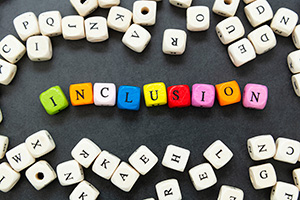10 Ways to Be a Better Advocate for Your Institution’s LGBTQ Community
 Rob Keel, policy analyst and HR communication specialist at Motlow State Community College and a 2019-20 CUPA-HR Wildfire program participant, highlights takeaways from the National LGBTQ Task Force’s Creating Change Conference to help higher ed HR pros become better resources and advocates for the LGBTQ communities on their campuses.
Rob Keel, policy analyst and HR communication specialist at Motlow State Community College and a 2019-20 CUPA-HR Wildfire program participant, highlights takeaways from the National LGBTQ Task Force’s Creating Change Conference to help higher ed HR pros become better resources and advocates for the LGBTQ communities on their campuses.
In January 2020, I traveled from rural Tennessee to Dallas, Texas, to join LGBT+ students, colleagues, thought leaders and allies at the Creating Change Conference hosted by the National LGBTQ Task Force, which included a day-long institute led by the Consortium of Higher Education LGBT Resource Professionals. Attending this conference provided me with a unique opportunity to learn more about common struggles of the LGBTQ community. Although it is impossible to capture everything that was shared, here are 10 insights higher ed HR professionals can use as they work to build better DEI practices:
- Allowing a diverse population to attend or work at your institution does not mean it is safe for us to work there.
The work does not stop once diversity is achieved. Inclusion takes effort, feedback and insight from populations that have historically and systemically been marginalized. - Intersectionality matters.
Without queer and trans people of color, the LGBTQ+ movement and history would be very different. If people of color are not at the table or leaders for the initiatives, the institution is already working from a disadvantage and setting itself up for failure. It is not only about what you do, but also who you involve at every step of planning and execution. - It has never been just about bathrooms.
When considering whether there is discrimination or bias in thinking about access to resources, try using this sentence as a test: “_______ people cannot use this space.” Now, try using different races in the blank. Then, use different religions. This can go on with nationalities, sexes, incomes, etc. Feels gross, right? It feels just as gross to put different orientations or gender identities in that blank. - Forms can create access barriers and anxiety, especially during the onboarding or orientation process.
Inevitably, the question of sex or gender will come up repeatedly during the application and orientation process. How is the new member of your institution supposed to know what is really needed there? Is the question asking if I was assigned male at birth for Selective Service reasons? Is it trying to ensure I know the gender marker on my drivers license and birth certificate? Will I be misgendered on every piece of automated email or mail if I mark the one I am told? Someone should be able to help new hires or students navigate these barriers. - Ensure your fundraising event or alumni homecoming is ready for me and my family before you send the invitation.
From having to take down wedding pictures in their office to being offered only one ticket to events while straight and cisgender colleagues were asked about their plus one, the stories about ways institutions have displayed bias were numerous and emotional. - Outing a colleague or student not only may violate HIPAA or FERPA, but also may put them at risk of violence.
In 2018, the average lifespan of a transgender woman of color in the United States was 36 years old. Worldwide, the life expectancy of transgender women of color was only 27 years old. In the first seven months of 2020, the number of transgender people murdered has already surpassed the total number murdered in 2019. - Nothing about us, without us.
When DEI initiatives start or evolve, the populations that have previously been pushed to the margins need to be directly involved. Representation matters, and there are subject experts out there. Avoid the pattern of expecting extra labor from minorities as consultants without compensation. If you need a consultant, pay them whenever possible. - In DEI work, there is always room for improvement.
At every event, the National LGBTQ Task Force and the Consortium of Higher Education LGBT Resource Professionals are exposed to opportunities to do better and held accountable by the community. Likewise, every higher ed event has the opportunity to create a culture of continuous improvement that will benefit DEI institution-wide. - Don’t just mourn with us, celebrate with us.
LGBTQ populations have a lot of struggles, but they also have daily victories. They shatter glass ceilings and bust down doors that were previously closed. Acknowledging those wins is an important part of being an advocate. - Invest in a support system for your employees working with diverse populations.
Institutional memberships to DEI organizations help provide a network of support even if there is not much representation at your institution. Employees working with at-risk populations need colleagues to learn from and thought leaders to push them professionally. The return on investment can be life-saving for your staff and students.
Additional Resources:
Diversity, Equity and Inclusion Toolkit (CUPA-HR members-only)
Gender Identity in the Workplace Toolkit (CUPA-HR members-only)
Genetic Information Nondiscrimination Act of 2008 (GINA) Toolkit (CUPA-HR members-only)


